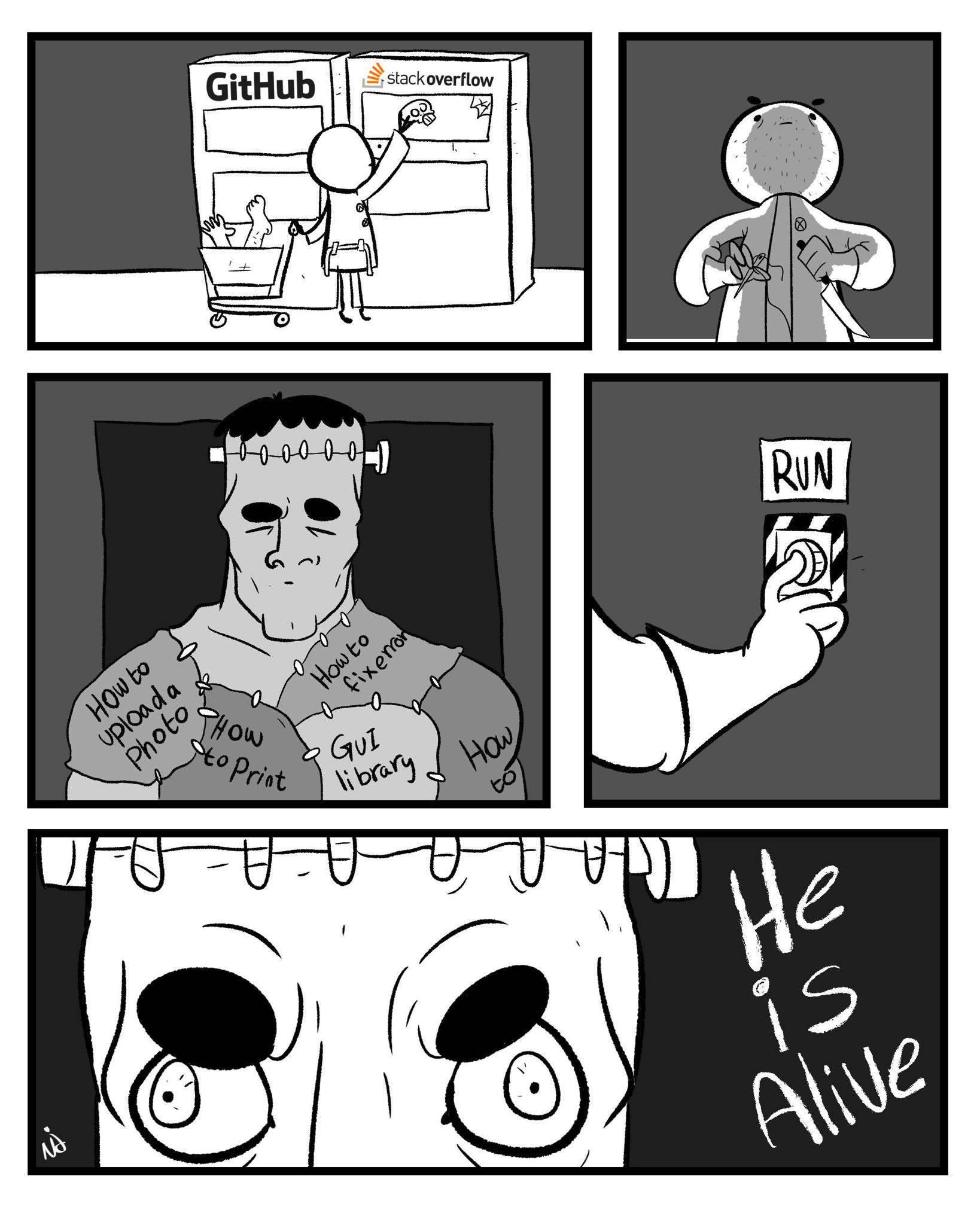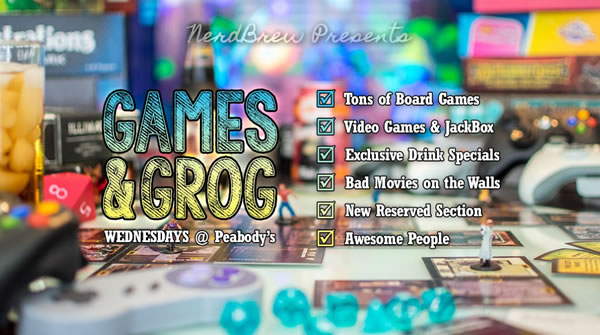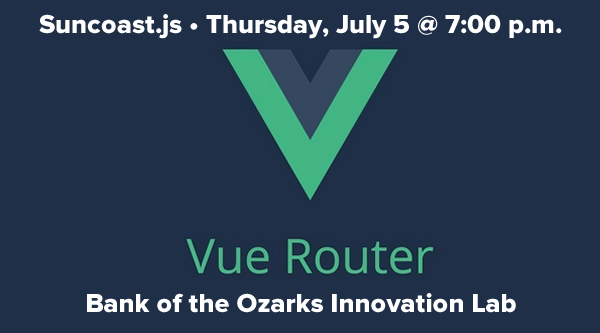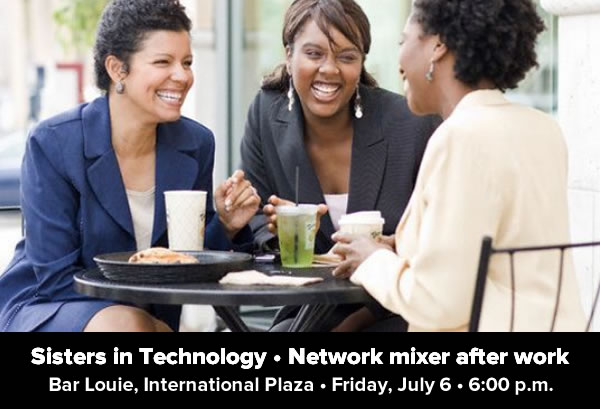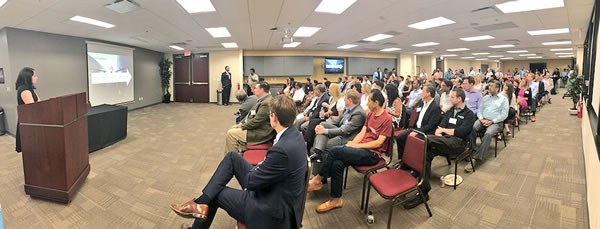Click the image to see it at full size.
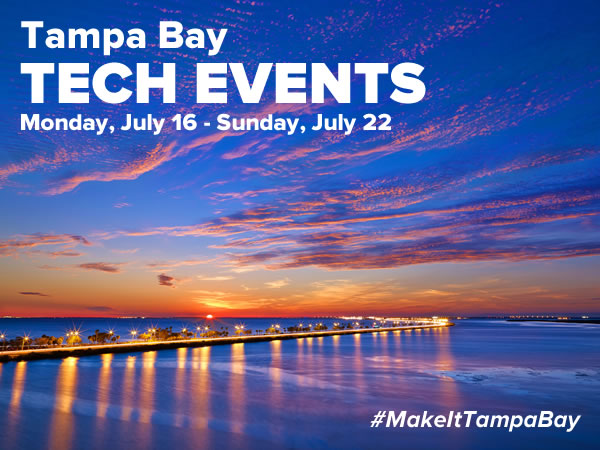
Every week, I compile a list of events for developers, technologists, tech entrepreneurs, and nerds in and around the Tampa Bay area. We’ve got a lot of events going on this week, and here they are!
Monday, July 16
- Code for Tampa Bay Brigade — July St. Pete MeetUp: NDCH Update @ TEC Garage, 6:00 PM to 8:00 PM
- Tampa Bay DevOps Monthly Meetup: discussion about source control @ Salesforce Tampa, 6:30 PM to 9:00 PM
- Cool ‘n Confident Toastmasters @ SPC – St. Petersburg/Gibbs Campus, 6:30 PM to 8:00 PM
- Largo Board Games Meetup — Gloomhaven @ 7:00 PM to 10:00 PM
- Nerdbrew Trivia — Pints & Pixels + Mario Party Tournament! @ Brew Bus, 7:00 PM to 11:00 PM
- Tampa Bay Bitcoin — Mining Mondays @ BlockSpaces, 7:00 PM to 9:00 PM
- South Tampa Toastmasters @ Unity of Tampa, 7:00 PM to 8:15 PM
Tuesday, July 17
- Westshore Toastmasters @ FIVE Labs, 12:00 PM to 1:00 PM
- Tampa SQL User Groups — Off I Go Into The Wild Azure Yonder… @ St Pete College – EpiCenter, 6:00 PM to 9:00 PM
- Weekly Open Make Night @ Tampa Hackerspace, 6:00 PM to 10:00 PM
- Tampa Bay Python — Python Round Table @ Salesforce Tampa, 6:30 PM to 8:30 PM
- Game Club Tampa Meetup — Tuesday Nite Roleplayers (RPGs) @ Grand Arena of Mind Expansion, 6:30 PM to 9:30 PM
- St. Pete Beers ‘n Board Games Meetup for Young Adults @ Flying Boat Brewing Company, 7:00 PM to 10:00 PM
- Orlando Entrepreneurs Network — Network After Work with Like Minded Entrepreneurs and Grow Your Business @ Welcome Room WellCare Health Plans, 7:00 PM to 9:00 PM
Wednesday, July 18
- Leads and Coffee @ Belleair Coffee Company, 7:45 AM to 9:15 AM
- OPEN/FREE Coworking for Veteran Entrepreneurs @ FirstWaVE Venture Center, 9:00 AM to 6:00 PM
- 1 Million Cups St. Pete — Sunshine Straw Co / Karts for Kids @ St. Petersburg Greenhouse, 9:00 AM
- 1 Million Cups Tampa — Startup Space, LLC / Academy at Suncoast Developers Guild @ Entrepreneur Collaborative Center, 9:00 AM
- Learn Cybersecurity Tampa — Career Convos: Ralph May @ SecureSet Tampa Campus, 5:00 PM to 7:30 PM
- Tampa Bay UX Group — Virtual Meetup: 6 Lightning Talks at 6 – Seeking More Speakers! @ 6:00 PM to 8:00 PM
- The Suncoast Linux Users Group — SLUG – Pinellas: ☢️ Unicode Astral Plane & Problems with MySQL Unicode Collation @ Pinellas Park Public Library, 6:00 PM to 8:00 PM
- Suncoast Developers Guild — Crash Course: .NET on a Mac @ Suncoast Developers Guild, 6:00 PM to 7:30 PM
- Tampa Artificial Intelligence Meetup — AI Study Group Meeting @ Town ‘N Country Regional Public Library, 6:30 PM to 8:30 PM
- Tampa Bay Bitcoin — Bitcoin/Cryptocurrency/Blockchain Meetup: News, Q&A, Networking, Social @ BlockSpaces, 7:00 PM to 10:00 PM
Thursday, July 19
- Tampa Otaku — MetroCon: Year 16 @ Tampa Convention Center, 10:00 AM to Sunday, 6:00 PM
- JULO Strategy Entrepreneur Meetups — CEO Exchange @ Pilot Bank (3415 West Bay to Bay Boulevard, Tampa), 11:00 AM to 1:00 PM
- Brandon Boardgamers — Let’s Game on Thursdays @ Panera Bread (3490 Lithia Pinecrest Road, Valrico), 5:30 PM to 9:30 PM
- Lean Beer for All Things Agile @ Zydeco Brew Werks, 6:00 PM to 7:30 PM
- Geekocracy! — ‘3rd Thursday’ Food Trucks and Live Music @ The Grand Central at Kennedy, 6:00 PM to 10:00 PM
- WITI – Tampa Bay (Women in Technology International) — Mess Up Night! Leadership Mess Up Lessons Learned @ SOFWERX Underground, 6:00 PM to 8:00 PM
- Tampa SEO and Internet Marketing Monthly Meetup with Steve Scott @ 6:00 PM to 8:00 PM
- WordPress St. Petersburg — Ask Us Anything – WordPress Project & Support Crowdsourcing Meetup @ TEC Garage at SPC Downtown Campus, 6:30 PM to 8:30 PM
- Tampa Bay Geek Association — Movie Night: Ant-Man & The Wasp @ AMC Highwoods 20, 6:30 PM to 10:00 PM
- Fusion 360 Open Workshop @ Tampa Hackerspace, 7:00 PM to 10:00 PM
- The Tampa Ruby Brigade — Tampa.rb: 12 Year Anniversary Party! @ Suncoast Developers Guild, 7:00 PM to 10:00 PM
- Hyperledger Tampa — Introduction to Hyperledger @ BlockSpaces, 7:00 PM to 9:00 PM
Friday, July 20
- Lean Coffee for All Things Agile (Downtown Tampa & Seminole Heights) @ FOUNDATION coffee co., 7:30 AM to 8:30 AM
- Café con Tampa @ Oxford Exchange, 8:00 AM to 9:00 AM
- Tampa Bay Cyber Security Meetup — Tampa Bay ISSA Chapter Event (non-members are welcome) @ 8:30 AM to 12:00 PM
- Anime, Nerds & Geeks — METROCON 2018 @ 11:00 AM to Sunday, 5:00 PM
- Tampa Bay Agile — Grow Financial Agile Tour @ Grow Financial, 11:00 AM to 12:00 PM
- Learn Cybersecurity Tampa — Capture the Flag: Cybersecurity Hackathon! @ SecureSet Tampa Campus, 5:30 PM to 8:30 PM
- Tampa Monopoly Meetup July Metup @ Panera Bread (112 S Westshore, Tampa), 6:45 PM to 9:30 PM
- Tampa Bay Area Software Craftsmanship Meetup — Craftsmanship and Wings @ Lee Roy Selmon’s, 7:00 PM to 10:00 PM
Saturday, July 21
- Kakkoii-Otaku Clan — Metrocon @ 10:00 AM to 6:00 PM
- Tampa Drones Meetup — 3D Mapping With Drones 101 @ Rasmussen College, 10:00 AM to 1:00 PM
- Tampa Drones Meetup — Open Fly Day @ Ed Radice, 10:00 AM to 1:00 PM
- Microcontroller Monthly Meetup (M3) @ Tampa Hackerspace, 1:00 PM to 4:00 PM
- Tampa Social Networking Meetup — Food & Craft Beer walking tours @ 1:00 PM to 4:00 PM
- Tampa Unity User Group — Game Project Therapy @ Perkins Restaurant & Bakery, 3:00 PM to 6:00 PM
- New Port Richey Casual Games and Fun Socializing Group! — C’mon Dine & Play at IHOP! US 19 near Sam’s Club @ IHOP on US 19 in NPR, kinda near Sam’s Club!, 5:30 PM to 10:00 PM
- Nerd Night Out — Game Night @ Old Northeast Tavern, 7:00 PM to 11:00 PM
Sunday, July 22
Luke Skywalker’s help desk
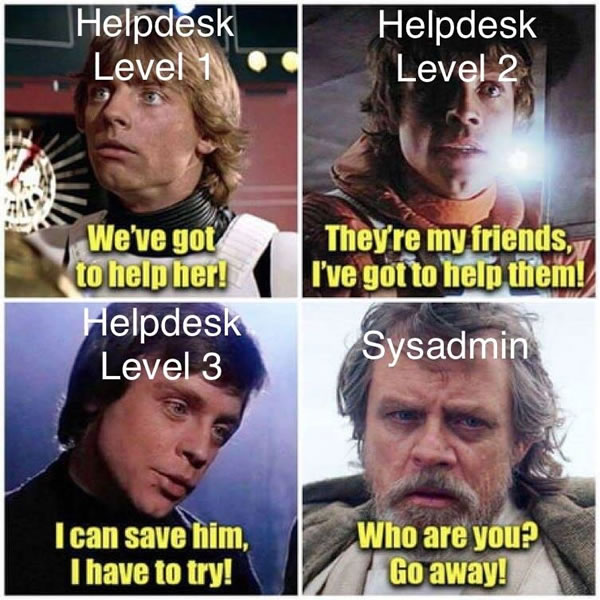
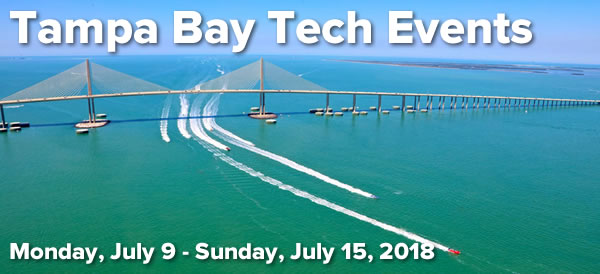
Every week, I compile a list of events for developers, technologists, tech entrepreneurs, and nerds in and around the Tampa Bay area. We’ve got a lot of events going on this week, and here they are!
Monday, July 9
- Tampa Bay Scrum Masters Guild @ ISC(2), 6:00 PM to 8:00 PM
- Tampa Unity User Group — Show Us Your Game! @ Imagine-Invent-Create, 6:30 PM to 9:00 PM
- Cool ‘n Confident Toastmasters @ SPC – St. Petersburg/Gibbs Campus, 6:30 PM to 7:45 PM
- Nerdbrew Trivia — Pints & Pixels Gaming Night! @ Brew Bus, 7:00 PM to 11:00 PM
- Nature Coast Bitcoin — Crypto Monday Meetup – Bitcoin / Blockchain / Cryptocurrency @ Country Kitchen (20133 Cortez Boulevard, Brooksville), 7:00 PM to 9:00 PM
- Tampa Bay Thinkers — Cultural Stereotypes: Is there more of it in the current political environment? @ Carrollwood Cultural Center, 7:00 PM to 9:00 PM
- Tampa Bay Bitcoin — Mining Mondays @ BlockSpaces, 7:00 PM to 9:00 PM
- Toastmasters Division E — Lakeland Club ~ 2262 @ YMCA – South, Lakeland, 7:00 PM to 9:00 PM
- South Tampa Toastmasters @ Unity of Tampa, 7:00 PM to 8:15 PM
Tuesday, July 10
- Westshore Toastmasters @ FIVE Labs, 12:00 PM to 1:00 PM
- The International Digital Nomad Society @ The Hangar Resturant & Flight Lounge, 5:00 PM to 7:30 PM
- Tech4Good Tampa — Using Social Media to Tell Your Story @ Panera Bread (2285 Ulmerton Rd, Clearwater), 5:30 PM to 6:30 PM
- Learn Cybersecurity Tampa — SecureSet Info Night Tampa @ SecureSet Tampa Campus, 6:00 PM to 7:00 PM
- Suncoast Developers Guild — Crash Course: Ruby for the Newbie @ Suncoast Developers Guild, 6:00 PM to 7:30 PM
- Weekly Open Make Night @ Tampa Hackerspace, 6:00 PM to 10:00 PM
- Upskill Tampa — Why Coding? @ 7:00 PM to 8:00 PM
- Code Katas — Let’s Do Some Fun Code Challenges! @ Suncoast Developers Guild, 7:00 PM to 10:00 PM
- Tampa Bay Social Media Meetup — Web Entrepreneurs @ Tampa Bay Technology Center, 7:00 PM to 10:00 PM
- Woodshop Safety (Members Only) @ Tampa Hackerspace, 7:15 PM to 9:15 PM
- Kakkoii-Otaku Clan — Attack on Titan Season 3 World Premiere Event (Subbed Viewing) @ 7:30 PM to 10:00 PM
- OK TRANSMIT! Art + Technology Meetup @ Duncan McClellan Gallery, 7:30 PM to 9:30 PM
Wednesday, July 11
- Tampa Bay WaVE — Open/FREE Coworking for Women Tech Entrepreneurs @ FirstWaVE Venture Center, 9:00 AM to 8:00 PM
- 1 Million Cups St. Pete — HypnoSheep Creative / Academy at Suncoast Developers Guild @ St. Petersburg Greenhouse, 9:00 AM
- 1 Million Cups Tampa — Ubuntu Innovations / Showered and Empowered, Inc. @ Mark Sharpe Entrepreneur Collaborative Center, 9:00 AM
- Learn Cybersecurity Tampa — Hacking 101: Network Security @ SecureSet Tampa Campus, 5:00 PM to 7:00 PM
- Tampa Bay Blockchain Developers Meetup — Open code @ Blockspaces, 5:00 PM to 8:00 PM
- Geekocracy! — HSIOW: Wednesday Hangout at the Parcade! @ The Lowry Parcade and Tavern, 5:30 PM to 8:30 PM
- Tampa Artificial Intelligence Meetup — #PrettyInGAN Visual Art with AI/Machine Learning @ Entrepreneur Collaborative Center, 6:30 PM to 8:00 PM
- Tampa Bay Data Science Group standard meeting @ Tampa Bay Wave, 6:30 PM to 9:30 PM
- Crypto Investors Club @ Panera Bread (1908 4th Street North, Saint Petersburg), 6:30 PM to 8:30 PM
- Design St Pete Happy Hour @ Flying Boat Brewing Company, 6:30 PM to 9:00 PM
- Suncoast Developers Guild — Open Code @ Callyo, 7:00 PM to 9:00 PM
- Tampa Bay Android Developers Group — TBD @ Bank of the Ozarks’ Innovation Lab, 7:00 PM to 9:00 PM
- Introduction to Fusion 360 @ Tampa Hackerspace, 7:00 PM to 10:00 PM
- Laser Cutter Orientation @ Tampa Hackerspace, 7:00 PM to 9:00 PM
- The Suncoast Linux Users Group — SLUG – Tampa @ New HDR Location, 7:00 PM to 9:00 PM
- Nerdbrew Trivia — Games & Grog @ Peabody’s!, 7:00 PM to 11:00 PM
- Women In Linux — Understanding Linux @ 7:00 PM to 9:00 PM
Thursday, July 12
- Zoho Tampa User Group — Enhanced features in Zoho CRM @ CoWork Tampa, 1:30 PM to 4:30 PM
- Tampa Bay Technology and Marketing Mastermind — FREE Fine Menswear Networking Event: “Buy Men’s top brands at 80% discount! @ McB’s Menswear Shop – Downtown St Pete, 5:30 PM to 8:00 PM
- Suncoast Caring Community Toastmasters @ The Garden House at Suncoast Hospice, 5:45 PM to 6:45 PM
- Tampa Bay Wave’s Pitch Night at Station House @ Station House, 6:00 PM to 9:00 PM
- St. Pete Makers — Intro to Soldering @ St. Pete Makers – new location, 6:30 PM to 8:30 PM
- Girl Develop It Tampa Bay — GDI 100K Celebration! with FED & SDG @ 3 Daughters Brewing, 7:00 PM to 9:00 PM
- Hyperledger Tampa — Introduction to Hyperledger @ BlockSpaces, 7:00 PM to 9:00 PM
Friday, July 13
- Lean Coffee for All Things Agile (Waters Location) @ Panera Bread (6001 W Waters Ave, Tampa), 7:30 AM to 8:30 AM
- Lean Coffee for All Things Agile (St Petersburg / Tyrone) @ Panera (2420 66th St North, St Petersburg), 7:30 AM to 8:30 AM
- Café con Tampa @ Oxford Exchange, 8:00 AM to 9:00 AM
Saturday, July 14
- R-Ladies Tampa – GitHub and Version Control @ Jan Kaminis Platt Regional Library, 10:00 AM to 11:30 AM
- Geekocracy! — GuardianCon: Gamer Convention And Charity Event! @ The Tampa Bay Convention Center, 11:00 AM to 5:00 PM
- Game Club Tampa Meetup — Learn to Game Master @ Grand Arena of Mind Expansion, 12:00 PM to 4:00 PM
- Geekocracy! — Board Game Night Party: July! @ 7:00 PM to 12:00 AM
- Nerd Night Out — KARAOKE NIGHT! @ Fat Cat Tavern, 8:30 PM to 12:30 AM
Sunday, July 15
- Tampa Bay Blockchain Developers Meetup / Ethereum Tampa Bay — Intro to cryptoeconomics @ BlockSpaces, 1:00 AM to 5:00 AM
- Tampa Python Meetup — Resume Builder: New Student Orientation / Work in Progress Review @ 10:30 AM to 12:30 PM
- Sew What? (Textile Arts & Crafts) @ Tampa Hackerspace, 5:30 PM to 8:30 PM
- Indie Game Jammers — Game Jam Progress Showcase @ Google Hangout, 7:00 PM to 9:00 PM
- Kids’ Open Make Day @ Tampa Hackerspace, 7:00 PM to 9:00 PM
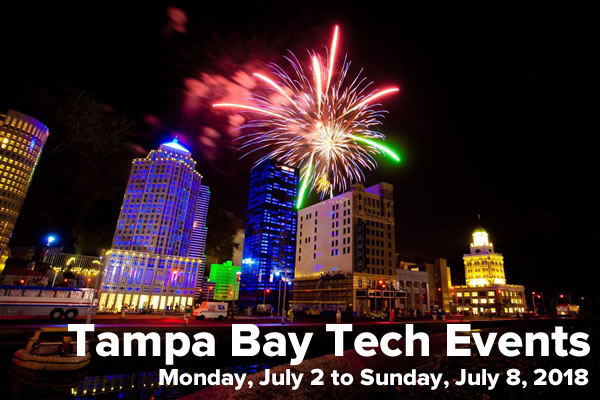
Monday, July 2
- Thinkful Online Info Session: Getting Started with Tech @ Online, 12:30 PM to 1:30 PM
- Code for Tampa Bay Brigade — July Tampa MeetUp: NDCH Update @ Entrepreneur Collaborative Center, 6:00 PM to 8:00 PM
- Cool ‘n Confident Toastmasters @ SPC – St. Petersburg/Gibbs Campus, 6:30 PM to 7:45 PM
- Nerdbrew Trivia — Pints & Pixels Gaming Night! @ Brew Bus, 7:00 PM to 11:00 PM
- YouTube Support Group — Generate more profits from your customers! @ Village Inn (9107 4th Street, St. Petersburg), 7:00 PM to 9:00 PM
- Tampa Bay Bitcoin — Mining Mondays @ BlockSpaces, 7:00 PM to 9:00 PM
- South Tampa Toastmasters @ Unity of Tampa, 7:00 PM to 8:15 PM
- Thinkful Online Info Session: Becoming a Web Developer @ Online, 8:00 PM to 9:00 PM
Tuesday, July 3
- Westshore Toastmasters @ FIVE Labs, 12:00 PM to 1:00 PM
- Tampa Hackerspace member meeting @ Tampa Hackerspace, 6:00 PM to 7:00 PM
- Game Club Tampa Meetup — Tuesday Nite Roleplayers (RPGs) @ Grand Arena of Mind Expansion, 6:30 PM to 9:30 PM
- St Pete .NET Meetup — Searching For My Lost Button with Harish Beeram @ Bank of the Ozarks Innovation Lab, 7:00 PM to 9:00 PM
- Palm Harbor eMarketing Groups — Internet Marketing for Business Owners @ IHOP, 30200 (US Hwy 19 South of Curlew Rd, Clearwater),7:00 PM to 10:00 PM
- St. Pete Beers ‘n Board Games Meetup for Young Adults @ Flying Boat Brewing Company, 7:00 PM to 10:00 PM
- Tampa Bay Bitcoin — Trading Tuesday! @ BlockSpaces, 7:00 PM to 9:00 PM
Wednesday, July 4
Note: Certain event sites like Meetup.com like to automatically schedule events, often without the organizers being aware of it. Before you attend any events on the 4th of July, check with the organizers first!
- Open/FREE Coworking for Latino Tech Entrepreneurs @ FirstWaVE Venture Center, 8:00 AM to 11:00 AM
- Nerdbrew Trivia — Games & Grog at Peabody’s @ Peabody’s Billiards and Games, 7:00 PM to 11:00 PM
Thursday, July 5
- Drupal Website Development, Design & Technologies Meetup — Modern Web Design & Development Meetup, focusing on Drupal CMS @ Panera Bread (2285 Ulmerton Road, Clearwater), 6:00 PM to 8:00 PM
- WordPress St. Petersburg — SEO in WordPress: Tools & Strategies @ TEC Garage at SPC Downtown Campus, 6:30 PM to 8:30 PM
- Suncoast.js — Leveraging the Power of Vue Router and React Components @ Bank of the Ozarks’ Innovation Lab, 7:00 PM to 9:00 PM
- Thinkful Online Info Session: Getting Started with Data Science @ Online, 8:00 PM to 9:00 PM
Friday, July 6
- Lean Coffee for All Things Agile (St Petersburg) @ Panera Bread (2285 Ulmerton Road, Clearwater), 7:30 AM to 8:30 AM
- Lean Coffee for All Things Agile (Carrollwood) @ Maple Street Biscuit Company, 7:30 AM to 8:30 AM
- Operation Startup — Quickbooks online accounting basics @ Entrepreneur Collaborative Center, 9:00 AM to 10:00 AM
- Operation Startup — Human Resources for small business @ Entrepreneur Collaborative Center, 10:00 AM to 11:00 AM
- Operation Startup — Government Contracting @ Entrepreneur Collaborative Center, 11:00 AM to 12:00 PM
- Thinkful Online Free Crash Course: Basic JavaScript @ Online, 12:30 PM to 1:30 PM
- Thinkful Online Free Crash Course: Basic JavaScript @ Online, 3:30 PM to 4:30 PM
- Learn Cybersecurity Tampa — Capture The Flag @ SecureSet, 6:00 PM to 8:00 PM
- Sisters in Technology — Network Mixer after work @ Bar Louie (International Plaza), 6:00 PM to 7:30 PM
Saturday, July 7
- Virtual Reality for Kids @ Seminole Community Library, Seminole, 10:00 AM to 11:00 AM
- The Tampa Bay Steampunk Society — Aethertopia: Celebrating the Genius of Steampunk Makers! @ Florida State Fair Grounds, 10:00 AM to Sunday 4:00 PM
- Cigar City Multirotors — Meet, Greet and Fly! @ Hamilton Park, 10:30 AM to 1:30 PM
- Machine Shop Safety and Cleanup (Members Only) @ Tampa Hackerspace, 10:30 AM to 11:00 AM
- Machine Shop Lathe 101 (Members Only) @ Tampa Hackerspace, 11:00 AM to 12:30 PM
Sunday, July 8
Photo by Allie Felix. Click to see the source.
Last December, Tampa Bay Lightning owner and philanthropist Jeff Vinik hired Lakshmi Shenoy, VP Strategy and Business at the Chicago innovation hub 1871 to start a similar innovation hub here in Tampa Bay. Last night, Shenoy spoke to a packed room at a gathering organized by Tampa’s Indo-US Chamber of Commerce about the upcoming Tampa Bay Innovation Hub, which will be to Tampa Bay what 1871 is to Chicago.
I took notes and photos during her presentation, which I’ve shared below.
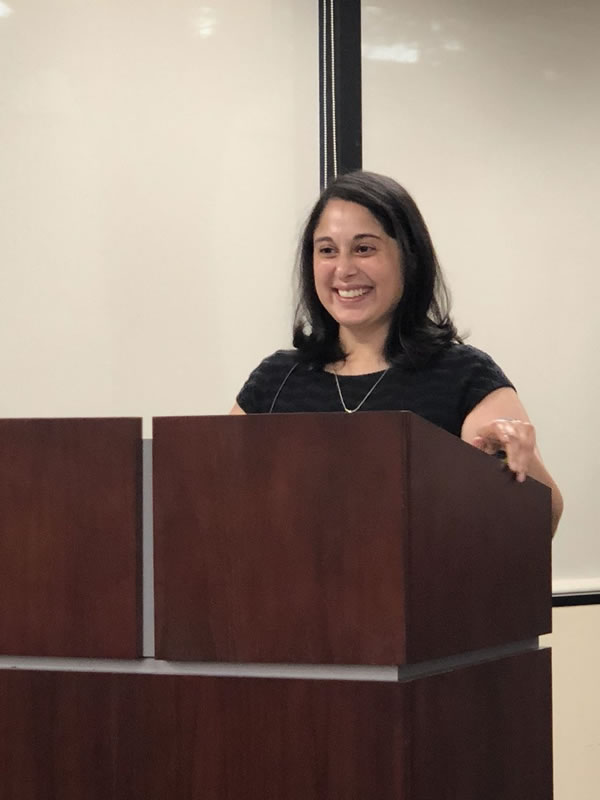
Introduction
- I was VP of Strategy and Business Development at 1871, an innovation hub located in Chicago’s Merchandise Mart
- The notion of an innovation hub is less than 10 years old
- 1871 has been described as “world class”. Why?
- It’s 140,000 square feet of space whose purpose us to bring together stakeholders and startups to help grow local technology entrepreneurship
- A place for 500 startups, 7 venture capitalist teams, several participating universities, and a stage that holds 1,000 public events a year
- It’s a central gathering point for technology and entrepreneurship
- I loved working with founders and teams at 1871
- The impact of startups is my personal force forward
The move to Tampa
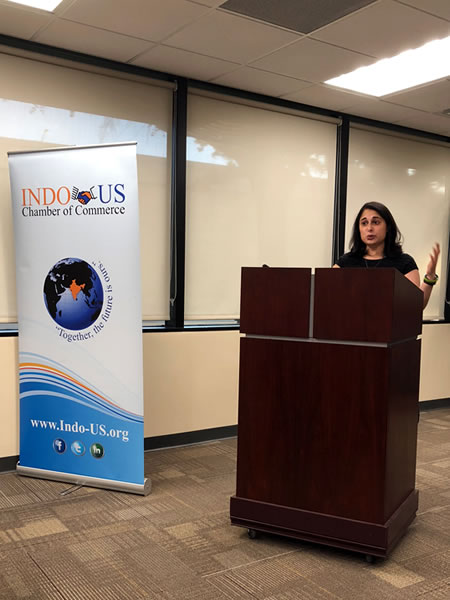
- I was hired to start an innovation hub in Tampa Bay last year, and moved here in February
- To get familiar with the area, I needed to leverage the knowledge of locals, and conducted over 200 interviews with them
- The locals were open and friendly
- From these interviews, I formed my strategy and concluded that Tampa Bay faces three key challenges:
- Access to talent and capital
- Density
- Tampa is spread out geographically
- Such a spread-out place could benefit from place making
- We need a landing zone that could act as a gathering place and that makes it easy for newcomers to find other people in the Tampa Bay tech/entrepreneurial scene
- Branding
- Startup talent doesn’t think of the Tampa Bay area as a place to set up their startup
- We need to make a team effort to promote Tampa Bay
- Use the hashtag #MakeItTampaBay
The Tampa Bay Innovation Hub
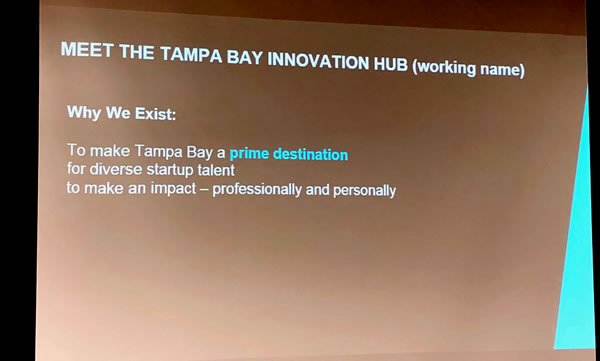
- “Tampa Bay Innovation Hub” is the legal name; the name that the place will go by is under wraps and will be announced soon
- We’re seeking talent who want to help us and want to be woven into community
- It’s a physical space whose purpose is to make Tampa Bay a startup place, similar to Station F in Paris
- It has 3 conceptual pieces:
- Practical: It gives you a place where you know where to go to find the Tampa Bay tech scene
- Emotional: It provides a community of people who understand the entrepreneur’s experiences and challenges
- Perception: It provides an image of activity, visual density, and an abundance of opportunity, and no one person or group up can do that
- It’s an ESO: an entrepreneurial support organization
The target and partners
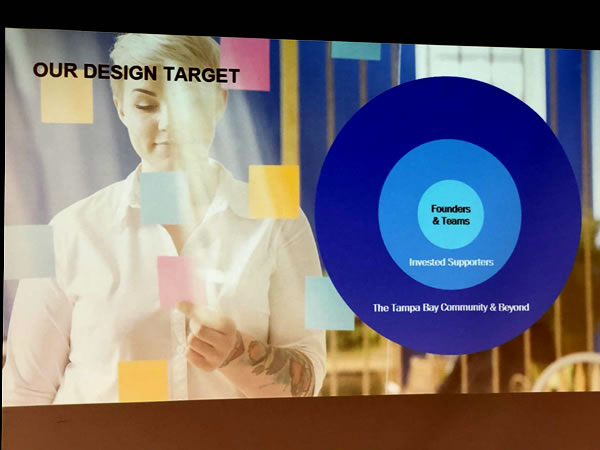
- We’re targeting 3 key groups:
- Founders and startup teams at the core
- Invested supporters
- Tampa Bay’s tech/entrepreneurial community and beyond, acting as positive stewards
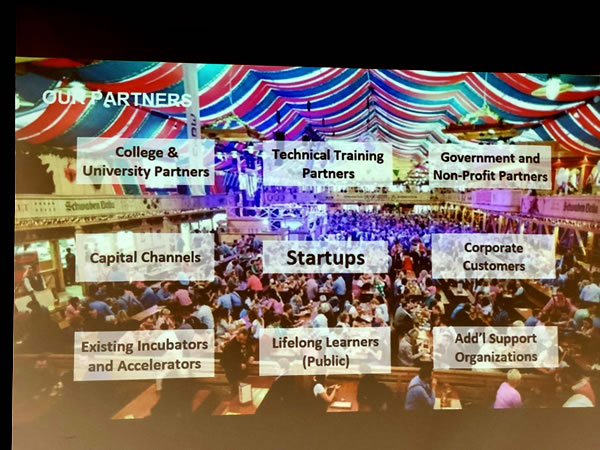
- It’s about creating a big tent that’s open to everyone who wants to be part of creating the conditions for startup success
- My KPIs are people
- We must:
- Have the density to retain people
- Develop anyone who wants to engage
- Future-proof people
- Create exposure and access to new tech
Coming soon
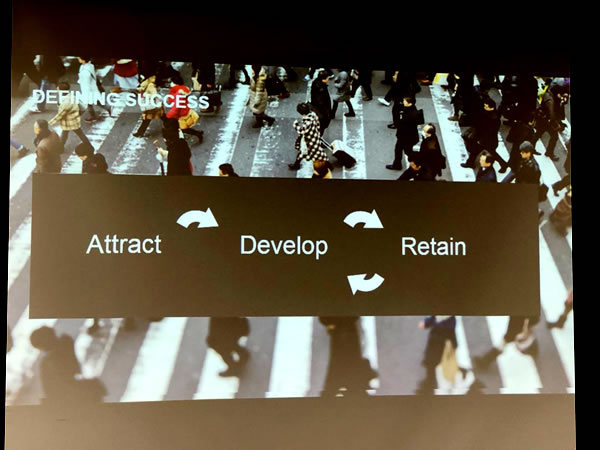
- The brand of the hub exists: it’s just under wraps
- We’re attracting local and international partners — that’s right: international partners!
- We want to announce space with wow factor
- Startup signups will start soon
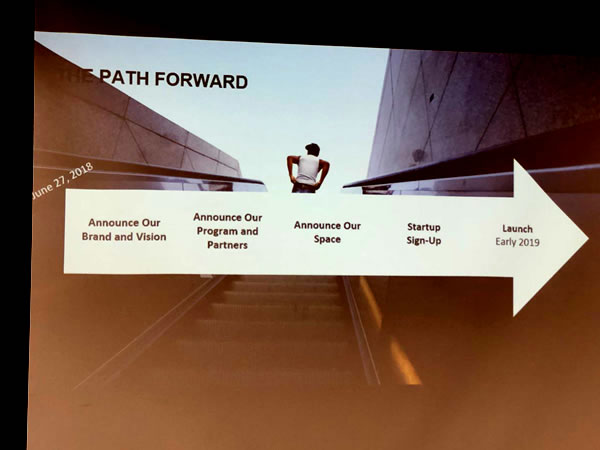
- This is a very special time for the Tampa Bay community
- When I came here last fall, I noticed an energy and optimism here
- I’m happy that I get to be part of this region’s story
We need to be our own #TampaBay brand advocates. Individuals create the authentic stories that something’s happening here. Share your story. Bring other people here so they can experience our #startup #entrepreneur community. @lshenoy #MakeItTampaBay pic.twitter.com/gPjqz5yrT4
— Anitra Pavka (@apavka) June 28, 2018
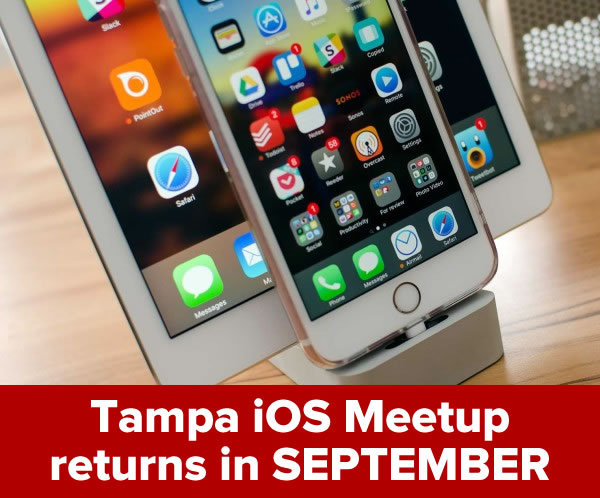
There WON’T be a Tampa iOS Meetup this coming Tuesday, June 26 — and there won’t be one in July or August either. Tampa iOS Meetup will return on Tuesday, September 25.
Things have become quite busy at work, and as a result, I have work and family events that take place at the same time as the usual Tampa iOS Meetup times for the next few months.
It may have looked like there were supposed to be meetups in June, July, or August, but that’s because Meetup.com likes to get ahead of itself. Once you start holding meetups at regular intervals (like Tampa iOS Meetup normally does, on the last Tuesday of the month), Meetup.com tries to help by automatically scheduling meetups on those dates into the foreseeable future. Sorry for any confusion that this may have caused.
I’ll still be around! If you have any questions, or want to talk about iOS, programming, or life in general, you can always reach me at joey@joeydevilla.com.
See you on Tuesday, September 25!
